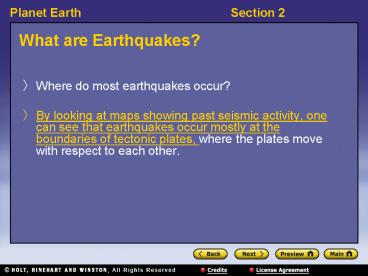What are Earthquakes? - PowerPoint PPT Presentation
1 / 16
Title:
What are Earthquakes?
Description:
Seismic waves are waves of energy released during an earthquake. ... scientists today more often use other scales, such as the moment-magnitude scale. – PowerPoint PPT presentation
Number of Views:114
Avg rating:3.0/5.0
Title: What are Earthquakes?
1
What are Earthquakes?
- Where do most earthquakes occur?
- By looking at maps showing past seismic activity,
one can see that earthquakes occur mostly at the
boundaries of tectonic plates, where the plates
move with respect to each other.
2
What are Earthquakes? continued
- Earthquakes are vibrations resulting from rocks
sliding past each other at a fault. - Seismic waves are waves of energy released during
an earthquake. - focus the location within Earth along a fault at
which the first motion of an earthquake occurs - epicenter the point on Earths surface directly
above an earthquakes starting point, or focus
3
Focus and Epicenter
4
What are Earthquakes? continued
- Energy from earthquakes is transferred by waves.
- The energy released from an earthquake is
measured as shock waves. - Earthquakes generate three types of waves
- Longitudinal waves, also known as P waves
- Transverse waves, also known as S waves
- Surface waves
5
What are Earthquakes? continued
- Waves move through Earth and along its surface.
- Both P waves and S waves spread out from the
focus in all directions through the earth. - Surface waves move only on Earths surface.
- surface wave a seismic wave that travels along
the surface of a medium and has a stronger effect
near the surface of the medium than it has in the
interior
6
Measuring Earthquakes
- How do scientists learn about earthquakes and the
Earths interior? - Because energy from earthquakes is transferred by
waves, scientists can measure the waves to learn
about earthquakes and about the interior of Earth
through which the waves travel.
7
Measuring Earthquakes, continued
- Seismologists detect and measure earthquakes.
- Seismologists use sensitive equipment called
seismographs to record data about earthquakes. - Records of seismic activity are called
seismograms. - seismology the study of earthquakes including
their origin, propagation, energy, and prediction
8
Measuring Earthquakes, continued
- Three seismograph stations are necessary to
locate the epicenter of an earthquake. - There are more than 1000 seismograph stations
across the world. - Because P waves travel faster, the difference
between the arrival of P waves and the arrival of
S waves allows scientists to calculate how far
away the focus is.
9
Measuring Earthquakes, continued
- Geologists use seismographs to investigate
Earths interior. - The way P and S waves travel through Earths
interior helps scientists make a model of Earth
with layers of different densities. - Scientists have used this information to develop
a model of Earths interior structure.
10
Measuring Earthquakes, continued
- The Richter scale is used to measure earthquakes.
- Although the Richter scale was used popularly for
much of the 20th century, scientists today more
often use other scales, such as the
moment-magnitude scale. - Richter scale a scale that expresses the
magnitude of earthquakes
11
Volcanoes
- What is a volcano?
- A volcano is any opening in Earths crust through
which magma has reached Earths surface. - crust an opening in the surface of Earth through
which volcanic material passes
12
Volcanoes
13
Volcanoes, continued
- Most volcanoes occur at convergent plate
boundaries. - 75 of the active volcanoes on Earth are located
in an area known as the Ring of Fire. - The Ring of Fire is located along the edges of
the Pacific ocean, where oceanic tectonic plates
are colliding with continental plates.
14
Ring of Fire
15
Volcanoes, continued
- Underwater volcanoes occur at divergent plate
boundaries. - As plates move apart at divergent boundaries,
magma rises to fill the gap. - This magma creates the volcanic mountains that
form ocean ridges. - Iceland is a volcanic island on the Mid-Atlantic
ridge that is growing outward in opposite
directions.
16
Volcanoes, continued
- Volcanoes occur at hotspots.
- Some volcanoes occur in the middle of plates.
- Mantle plumes are mushroom shaped trails of hot
rock that rise from deep inside the mantle, melt
as they rise, and erupt from volcanoes at hot
spots at the surface. - The plumes remain in the same place as the
tectonic plate moves, creating a trail of
volcanoes. - The Hawaiian Islands are an example of this type
of volcanic activity.































